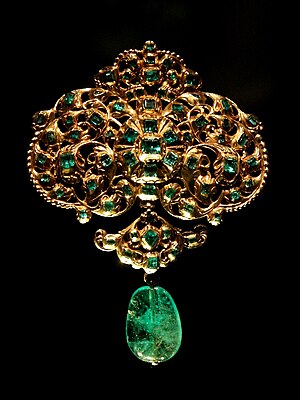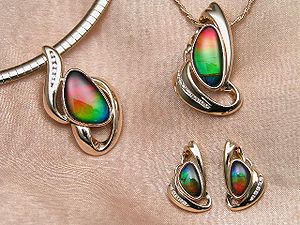Anodized: Refers to a method by which metal, such as aluminum, is coated with color by the proces of electrolysis.
Asterism: Star-like appearance of star rubies and star sapphires.
Balas Ruby: Rose-tinted spinel.
Chased Design: Fine lines indented in metal to outline the shap of design motif, used for copper, gold, and silver jewelry.
Chips: Tiny, uncut diamonds; sometimes used to surround a larger diamond stone in a ring, also used in the case of a watch, or in a watch band.
Chromium: A durable metal, resembles silver, used mainly for plating brass or copper. Does not tarnish, therefore, has advantage over silver-plated articles.
Ceramics: Porcelain, usually hand painted when used in jewelry.
Coral: Opaque, rose-pink, ox-blood, white, or yellow in color; the skeletons of sea animals, used for earrings, necklaces and bracelets.
Ivory: The hard creamy-white, opaque, fine-grained material of elephant tusks and the tusks of other animals; richly carved for use in jewelry.
Filagree: Lace-like jewelry made from wire of silver or gold.
Engine Turned: Line engraving applied to plain surface metal by hand or machine from master stencil.
Hammered: The surface of metal is maked by small, round hammer marks.
Jet: Black, opaque stone of hard-type coal that can be highly polished.
Mohs' Scale: The scale used to denote hardness and resistance to scratching . Ranging from diamond, which rates a 10, down to talc, the stone that is ground and screened for use in talcum powder, rates a 1.
Mother-of-Pearl: Iridescent, changeable, mily-white coloring; often carved, is the hard pearly internal layer of the shell of an oyster of other seashell.
Oxidize: Term used to designate the darkening pof designs on silver articles by chemicals to gie a richer effect.
Onyx: A stone, chalcedony, in parallel layers of different shades of color used especially in making cameos.
Neillo Engraving: Fine engraving filled with black enamel or alloy.
Paste Stones: Imitation glass stones, usually made of lead glass that has brilliance and sparkle. Made to imitate real stones.
Repousse Chasing: Design raised from the inside, to give molded effect
Rhinestone: A stone of glass, cut to resemble a diamond; usually backed with foil to give more brilliance and sparkle.
Rhodium: Metal resembling silver, rhodium-plated jewelry wears well; extremely small amounts are plated on fashion jewelry items because rhodium is expensive.
Rose Cut: Common type of facet cut: a stone so cut comes to a point at the top and has facets triangular in shape.
Stainless Steel: An alloy composed of steel, nickel and chromium; popular for watch cases and under portion of watch bands; for watches worn for sports and other activities. Wears well, does not tarnish or become discolored.
Swiss Lapis: Opaque, dark red quartz stone that is strained blue to resemble Lapis Lazuli for commercial purposes.
Tenth-Power Loop; Jewelr's magnifying glass that enlarges ten times.
"Good jewelry is timeless and therefore, one of the best fashion investments one can make. Don't just purchase jewelry, invest in it."
John Robert Powers

Asterism: Star-like appearance of star rubies and star sapphires.
Balas Ruby: Rose-tinted spinel.
Chased Design: Fine lines indented in metal to outline the shap of design motif, used for copper, gold, and silver jewelry.
Chips: Tiny, uncut diamonds; sometimes used to surround a larger diamond stone in a ring, also used in the case of a watch, or in a watch band.
Chromium: A durable metal, resembles silver, used mainly for plating brass or copper. Does not tarnish, therefore, has advantage over silver-plated articles.
Ceramics: Porcelain, usually hand painted when used in jewelry.
Coral: Opaque, rose-pink, ox-blood, white, or yellow in color; the skeletons of sea animals, used for earrings, necklaces and bracelets.
Ivory: The hard creamy-white, opaque, fine-grained material of elephant tusks and the tusks of other animals; richly carved for use in jewelry.
Filagree: Lace-like jewelry made from wire of silver or gold.
Engine Turned: Line engraving applied to plain surface metal by hand or machine from master stencil.
Hammered: The surface of metal is maked by small, round hammer marks.
Jet: Black, opaque stone of hard-type coal that can be highly polished.
Mohs' Scale: The scale used to denote hardness and resistance to scratching . Ranging from diamond, which rates a 10, down to talc, the stone that is ground and screened for use in talcum powder, rates a 1.
Mother-of-Pearl: Iridescent, changeable, mily-white coloring; often carved, is the hard pearly internal layer of the shell of an oyster of other seashell.
Oxidize: Term used to designate the darkening pof designs on silver articles by chemicals to gie a richer effect.
Onyx: A stone, chalcedony, in parallel layers of different shades of color used especially in making cameos.
Neillo Engraving: Fine engraving filled with black enamel or alloy.
Paste Stones: Imitation glass stones, usually made of lead glass that has brilliance and sparkle. Made to imitate real stones.
Repousse Chasing: Design raised from the inside, to give molded effect
Rhinestone: A stone of glass, cut to resemble a diamond; usually backed with foil to give more brilliance and sparkle.
Rhodium: Metal resembling silver, rhodium-plated jewelry wears well; extremely small amounts are plated on fashion jewelry items because rhodium is expensive.
Rose Cut: Common type of facet cut: a stone so cut comes to a point at the top and has facets triangular in shape.
Stainless Steel: An alloy composed of steel, nickel and chromium; popular for watch cases and under portion of watch bands; for watches worn for sports and other activities. Wears well, does not tarnish or become discolored.
Swiss Lapis: Opaque, dark red quartz stone that is strained blue to resemble Lapis Lazuli for commercial purposes.
Tenth-Power Loop; Jewelr's magnifying glass that enlarges ten times.
"Good jewelry is timeless and therefore, one of the best fashion investments one can make. Don't just purchase jewelry, invest in it."
John Robert Powers





















